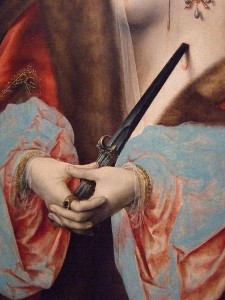In the dolorous, beautiful and heart-rending poem “The Rape of Lucrece”, Shakespeare writes these wonderful lines:-
To see sad sights moves more than to hear them told,
For then the eye interprets to the ear
The heavy motion that it doth behold,
When every part a part of woe doth bear.
‘Tis but a part of sorrow that we hear:
Deep sounds make lesser noise than shallow fords,
And sorrow ebbs being blown with wind of words.
The poem may be found on the Literature Network at http://www.online-literature.com/shakespeare/331/
The work will be presented at the Edinburgh Festival this year and details may be found at http://www.eif.co.uk/rapeoflucrece

The first painting, considered here, ofLucretia is that by Joos van Cleve, a Flemish artist dated 1525 (Oil on panel). The Rijksmuseum says,”Joos van Cleve was probably born in the town or province Kleve in Germany. He trained under a painter in Kalkar. Probably, he started working in Bruges in 1507. Later he moved to Antwerp, where he registered as a master painter in the painters guild. Van Cleve was one of the most influential painters in Antwerp. He received major commissions for portraits and altarpieces. In his paintings he combines a traditional approach with new elements. He was one of the first to paint broad landscapes in the background. In the north, painters began to show an interest in landscapes in the sixteenth century.” It is said that, that like Quentin Massys, a fellow artist of Antwerp, Joos van Cleve appropriated themes and techniques of Leonardo da Vinci.

Having recently seen Massys’s beautiful painting of Flora, 1559 in the Kunsthalle in Hamburg, I can vouch for its entrancing effect which has spurred me to look too at his splendid and interesting oeuvre.
This may be further explored at http://www.artcyclopedia.com/artists/massys_jan.html
There are 9 images for The Rape of Lucrece in the Lessing Archive http://www.lessing-photo.com/search.asp?a=1&kc=202020203B61&kw=RAPE+OF+LUCRETIA&p=1&ipp=6 of which that of Joos van Cleve, in my view, is the most moving. This is due partly to the intense use of colour and partly because of the composition. Her head is slightly raised and there is a plaintive and doleful expression on the face which clearly evokes her immeasurable sense of violation. The gesture is expressive rather than realistic and conveys the sense of drama, emphasised in the picture by the diagonal composition. The swirling dishabille of her dress and attendant necklace, the lacing, the elegant sleeving and in particular the looping arc about her headdress adds to the emotional sense of dire confusion. Her royalty is conveyed by these fine robes. The red and black surrounding the more delicate flesh tones add to the sense of catastrophe. Such emphatic use of colour reminded me of Munch’s painting of The Madonna with which it is interesting to compare and contrast, since this second painting with its languorous quality is quite different in terms of the feelings communicated. http://www.edvard-munch.com/gallery/women/madonna.htm

The second picture is by the renowned British print maker, Stanley William Hayter, whose magnificent work has appeared fairly recently at the Annex Galleries, http://www.myspace.com/annexgalleries/blog/433291678.Hayter, it is mentioned was, “A chemist by training, Stanley W. Hayter spent most of his life in Paris. He is often noted for his 1927 founding an experimental workshop for the graphic arts – Atelier 17-that played a central role in the 20th century revival of the print as an independent art form”. His knowledge of chemistry was obviously a great asset in his printmaking and a brief biography may be viewed at http://www.wolman-prints.com/pages/artistbiog/all/h/293.html His etching from 1934 appears to be in MOMA and further detail can be obtained from http://www.moma.org/collection/browse_results.php?criteria=O%3AAD%3AE%3A2558&page_number=3&template_id=1&sort_order=1

The etching and engraving which in a twisted and troubled composition in black and tones of grey, dramatically suggests the violence of the rape itself in convoluted tubes with a sharp diagonal point, perhaps suggestive of Tarquin’s arm but surely demonstrates the violence of the crime itself. The lower figure seems distraught and crudely exposed to the upper figure which appears too as some sort of metamorphosised fly with the same stabbing structure seeming like some horrific proboscis. Also Armion according to Wikipedia remarks upon,” The association between the phallus and the blade later becomes quite clear when Tarquin enters Lucrece’s chamber and threatens the young woman with his sword”. Here the abstract forms fully express the extremity of the situation. At this time, it appears Hayter had just moved to No. 17, Rue Campagne-Première and was, a few years later to collaborate with Miro, Kandinsky and Picasso on artwork for the Republican cause in Spain. Perhaps this is reminiscent of the significant political result of these events, that Lucius Junius Brutus, nephew of the last Tarquin King led the rebellion against him and founded theRomanRepublic.
Hayter was influenced by the Polish printmaker Józef Hecht, who introduced him to copper engraving. Hecht’s own prints and paintings are both interesting and highly engaging. http://mushecht.haifa.ac.il/art/GhezCollection_eng.aspx?id=8

Noisy Street
oil on canvas, 80×100 cm.

This is now playing in the Edinburgh Festival 2012, should be really interesting:-http://www.guardian.co.uk/music/2012/aug/13/camille-o-sullivan-rape-lucrece

2 replies on “Images from the Rape of Lucrece/Lucretia”
[…] Joos van Cleve. “Lucretia.” https://penwithlit.com/2012/07/01/images-from-the-rape-of-lucrecelucretia/ Mya Gosling. “The Rape of Lucrece (in 3 Panels).” […]
Thanks for that-very interesting and useful